A1 Charlotte Pest Control Companies - Your Neighborhood Pest Specialists
A1 Charlotte Pest Control Companies - Your Neighborhood Pest Specialists
Blog Article
Bed Pest Therapy Breakdown: Comparing Chemical Vs. Non-Chemical Solutions
In the world of parasite control, specifically when dealing with the persistent concern of bed pests, the option in between chemical and non-chemical therapy options can be a pivotal one. Both strategies offer unique advantages and downsides, influencing variables such as effectiveness, safety considerations, and general expense. By taking a look at the nuanced details of each technique, a clearer understanding of which course to go after in resolving a bed insect infestation can be achieved.
Performance of Chemical Treatments
Chemical therapies for bed bug infestations have actually been widely recognized for their powerful and quick efficacy in removing these parasites. When considering the effectiveness of chemical treatments, it is vital to understand that they can provide a quick and complete service to a bed insect issue.
Additionally, chemical treatments have the advantage of providing recurring impacts, indicating that they can remain to get rid of bed insects also after the preliminary application. This recurring activity is specifically valuable in combating any potential re-infestations. In addition, the rapid activity of chemical therapies can bring alleviation to individuals encountering extreme bed bug infestations, permitting them to restore control of their home promptly.
Security Worry About Chemical Solutions
One essential facet that requires cautious consideration when utilizing chemical services for bed pest treatment is guaranteeing the safety and security of residents and the atmosphere. Exposure to particular chemicals used in bed bug treatments can lead to breathing problems, skin irritation, or other damaging responses, specifically in people with pre-existing conditions or level of sensitivities.
Furthermore, the ecological effect of chemical options is one more considerable consideration. Some chemicals made use of in bed pest treatments might be dangerous to advantageous pests, wild animals, and ecosystems if they seep right into the soil or water systems. It is essential to make use of chemical therapies carefully, complying with safety standards, and considering much less hazardous choices to alleviate these risks and ensure the safe and effective administration of bed insect problems.
Benefits of Non-Chemical Strategies
Thinking about the prospective safety concerns and environmental influence linked with chemical services for bed pest treatment, discovering non-chemical approaches provides a promising alternative with several distinctive advantages. Non-chemical approaches use a much safer option for households, particularly those with children, people, or animals delicate to severe chemicals. These strategies eliminate the risks of exposure to toxic materials, lowering the possibility for damaging health results. Furthermore, non-chemical treatments are ecologically friendly, as they do not add to air or water contamination, making them a sustainable choice for bug control.
Additionally, non-chemical services can be efficient in targeting bed bugs, consisting of hard-to-reach locations where chemical treatments might not permeate. Methods such as warm therapy, vacuuming, vapor cleaning, and mattress coverings give extensive eradication without the use of hazardous chemicals. In addition, non-chemical techniques can be less turbulent, needing marginal prep work and enabling quicker reentry right into treated areas. On the whole, going with non-chemical bed insect therapy approaches not only prioritizes safety and security and environmental management however likewise makes certain effective and extensive bug control.
Limitations of Non-Chemical Treatments

Furthermore, non-chemical treatments usually require multiple applications to achieve successful removal. This can be lengthy and might not constantly assure complete elimination of all bed bugs and their eggs, specifically in hard-to-reach or covert locations.
In addition, the success of non-chemical treatments greatly counts on correct execution and thoroughness, which can be challenging for people without specialist knowledge. Inadequate application click reference of non-chemical techniques may cause incomplete elimination, causing relentless problems and the requirement for additional treatments.
Consequently, while non-chemical therapies have their advantages, it is important to recognize these limitations and consider them when establishing the most reliable method for managing bed insect invasions.
Expense Contrast: Chemical Vs. Non-Chemical Options
Offered the limitations linked with non-chemical treatments, an important element to assess in the context of bed bug management is the price contrast between chemical and non-chemical choices. In contrast, non-chemical therapies like warmth treatment or vapor can be a lot more expensive, with costs varying from $1,000 to $6,000 for a whole home. While the blog initial cost of chemical treatments might seem lower, numerous treatments might be needed to fully eliminate the problem, possibly enhancing the general cost.
Final Thought

Considering the prospective security problems and environmental effect linked with chemical services for bed pest treatment, discovering non-chemical approaches provides a promising option with numerous unique benefits.Provided the constraints associated with non-chemical therapies, a necessary aspect to examine in the context of bed pest management is pop over to this site the expense comparison in between chemical and non-chemical alternatives. In contrast, non-chemical treatments like warm treatment or heavy steam can be more expensive, with expenses varying from $1,000 to $6,000 for a whole home. While the initial expense of chemical therapies might appear reduced, numerous treatments might be called for to totally eliminate the invasion, possibly increasing the overall cost.In final thought, when comparing chemical and non-chemical bed insect treatment alternatives, it is vital to take into consideration effectiveness, safety, benefits, limitations, and cost.
Report this page